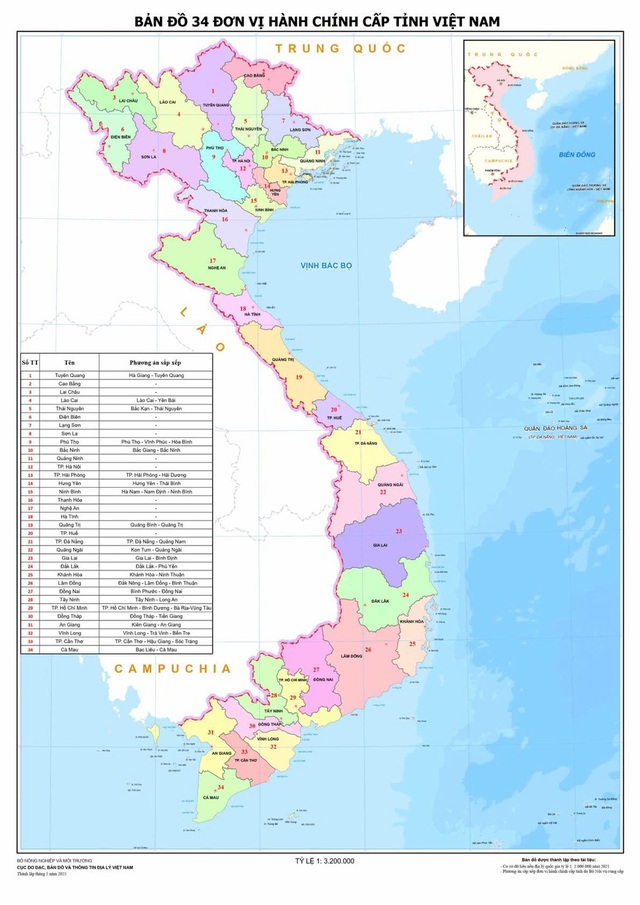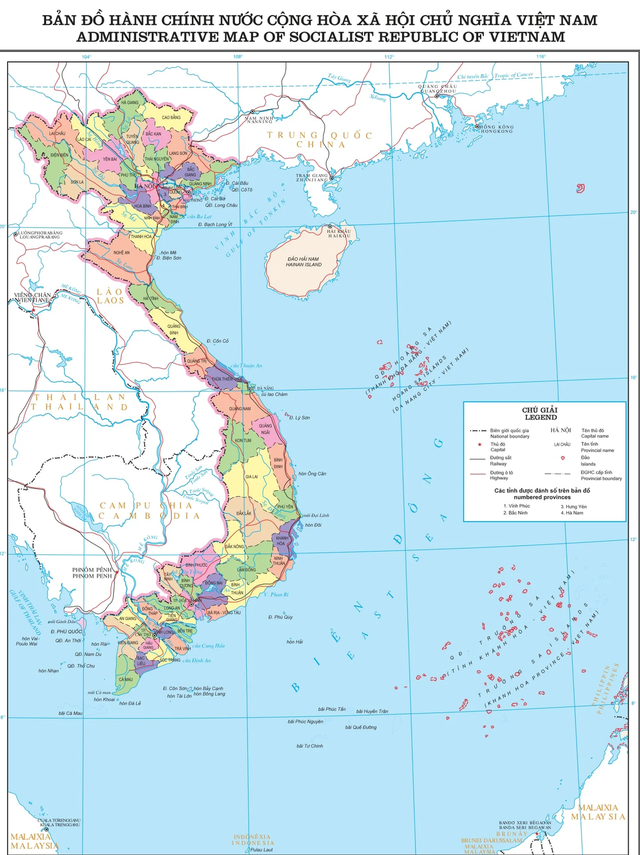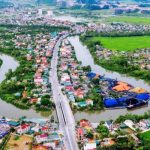Prior to June 12th, Vietnam comprised 63 provinces and cities, including 6 municipalities and 57 provinces nationwide. The map of the 63 provinces and cities was published by the Department of Surveying and Mapping, Ministry of Natural Resources and Environment (now the Ministry of Agriculture and Environment) at a scale of 1:9,000,000. It illustrates the administrative divisions and management at the provincial level within Vietnam’s territory, encompassing its mainland, seas, islands, and archipelagoes as follows:

Map of Vietnam with 63 provinces and cities (Source: Vietnam Administration of Surveying, Mapping, and Geography)
On the morning of June 12th, with 461 out of 465 delegates voting in favor (accounting for 96.44% of the total number of National Assembly deputies), the National Assembly passed a resolution on the rearrangement of administrative units at the provincial level in 2025. The country now has 34 administrative units at the provincial level, consisting of 28 provinces and 6 cities. The resolution takes effect from the date of its passage by the National Assembly.
The published administrative map illustrates that the country has 34 provinces, including 6 municipalities and 28 regular provinces.

Map of 34 administrative units at the provincial level in Vietnam, 2025. (Source: Vietnam Administration of Surveying, Mapping, and Geography)
Previously, our country stretched from Lung Cu, Ha Giang (the northernmost point) to Ca Mau Cape, Ca Mau Province (the southernmost point).
Following the merger of Ha Giang and Tuyen Quang provinces into a new province named Tuyen Quang, the country’s length now spans from Tuyen Quang to Ca Mau.
Before the merger, along the 3,260 km coastline, there were 28 coastal provinces and cities. This number has now decreased to 21 localities. However, the proportion of localities with a coastline has increased to 62% (21/34) compared to 44% (28/63) previously.
Notably, all localities in the Central Highlands region now have a coastline after the rearrangement.
Additionally, citizens can refer to the map of Vietnam’s 34 new provinces and cities here: This link
Details of the area and population of the 23 provinces and cities after the merger
Alongside 11 provinces that remain unchanged (Hanoi, Hue, Lai Chau, Dien Bien, Son La, Lang Son, Quang Ninh, Thanh Hoa, Nghe An, Ha Tinh, Cao Bang), the rearrangement plan affects 52 out of the total 63 provinces and cities nationwide as follows:
1. Merging the entire natural area and population of Ha Giang and Tuyen Quang provinces to form a new province named Tuyen Quang. Post-merger, Tuyen Quang province spans an area of 13,795.5 km2 with a population of 1.8 million people.
Tuyen Quang province borders Cao Bang, Lao Cai, Phu Tho, Thai Nguyen provinces, and the People’s Republic of China.
2. Merging the entire natural area and population of Yen Bai and Lao Cai provinces to form a new province named Lao Cai. Post-merger, Lao Cai province covers an area of 13,256.92 km2 with a population of 1.7 million people.
Lao Cai province borders Lai Chau, Phu Tho, Son La, Tuyen Quang provinces, and the People’s Republic of China.
3. Merging the entire natural area and population of Bac Kan and Thai Nguyen provinces to form a new province named Thai Nguyen. Post-merger, Thai Nguyen province has an area of 8,375.21 km2 with a population of 1.7 million people.
Thai Nguyen province borders Bac Ninh, Cao Bang, Lang Son, Phu Tho, Tuyen Quang provinces, and Hanoi capital.
4. Merging the entire natural area and population of Vinh Phuc, Hoa Binh, and Phu Tho provinces to form a new province named Phu Tho. Post-merger, Phu Tho province covers an area of 9,361.38 km2 with a population of 4 million people.
Phu Tho province borders Lao Cai, Ninh Binh, Son La, Thai Nguyen, Thanh Hoa, Tuyen Quang provinces, and Hanoi capital.
5. Merging the entire natural area and population of Bac Giang and Bac Ninh provinces to form a new province named Bac Ninh. Post-merger, Bac Ninh province spans an area of 4,718.6 km2 with a population of 3.6 million people.
Bac Ninh province borders Hung Yen, Lang Son, Quang Ninh, Thai Nguyen provinces, Hai Phong city, and Hanoi capital.
6. Merging the entire natural area and population of Thai Binh and Hung Yen provinces to form a new province named Hung Yen. Post-merger, Hung Yen province covers an area of 2,514.81 km2 with a population of 3.5 million people.
Hung Yen province borders Bac Ninh, Ninh Binh provinces, Hanoi capital, Hai Phong city, and the East Sea.
7. Merging the entire natural area and population of Hai Duong province and Hai Phong city to form a new city named Hai Phong. Post-merger, Hai Phong city has an area of 3,194.72 km2 with a population of 4.6 million people.
Hai Phong city borders Bac Ninh, Hung Yen, Quang Ninh provinces, and the East Sea.
8. Merging the entire natural area and population of Ha Nam, Nam Dinh, and Ninh Binh provinces to form a new province named Ninh Binh. Post-merger, Ninh Binh province covers an area of 3,942.62 km2 with a population of 4.4 million people.
Ninh Binh province borders Hung Yen, Phu Tho, Thanh Hoa provinces, Hanoi capital, and the East Sea.
9. Merging the entire natural area and population of Quang Binh and Quang Tri provinces to form a new province named Quang Tri. Post-merger, Quang Tri province spans an area of 12,700 km2 with a population of 1.8 million people.
Quang Tri province borders Ha Tinh province, Hue city, the Lao People’s Democratic Republic, and the East Sea.
10. Merging the entire natural area and population of Quang Nam province and Da Nang city to form a new city named Da Nang. Post-merger, Da Nang city covers an area of 11,859.59 km2 with a population of 3.06 million people.
Da Nang city borders Quang Ngai province, Hue city, the Lao People’s Democratic Republic, and the East Sea.
11. Merging the entire natural area and population of Kon Tum and Quang Ngai provinces to form a new province named Quang Ngai. Post-merger, Quang Ngai province has an area of 14,832.55 km2 with a population of 2.1 million people.
Quang Ngai province borders Da Nang city, Gia Lai province, the Lao People’s Democratic Republic, the Kingdom of Cambodia, and the East Sea.
12. Merging the entire natural area and population of Binh Dinh and Gia Lai provinces to form a new province named Gia Lai. Post-merger, Gia Lai province spans an area of 21,576.53 km2 with a population of 3.5 million people.
Gia Lai province borders Dak Lak, Quang Ngai provinces, the Kingdom of Cambodia, and the East Sea.
13. Merging the entire natural area and population of Ninh Thuan and Khanh Hoa provinces to form a new province named Khanh Hoa. Post-merger, Khanh Hoa province covers an area of 8,555.86 km2 with a population of 2.2 million people.
Khanh Hoa province borders Dak Lak, Lam Dong provinces, and the East Sea.
14. Merging the entire natural area and population of Dak Nong, Binh Thuan, and Lam Dong provinces to form a new province named Lam Dong. Post-merger, Lam Dong province has an area of 24,233.07 km2 with a population of 3.8 million people.
Lam Dong province borders Dak Lak, Dong Nai, Khanh Hoa provinces, Ho Chi Minh City, the Kingdom of Cambodia, and the East Sea.
15. Merging the entire natural area and population of Phu Yen and Dak Lak provinces to form a new province named Dak Lak. Post-merger, Dak Lak province covers an area of 18,096.4 km2 with a population of 3.3 million people.
Dak Lak province borders Gia Lai, Khanh Hoa, Lam Dong provinces, the Kingdom of Cambodia, and the East Sea.
16. Merging the entire natural area and population of Ba Ria-Vung Tau, Binh Duong, and Ho Chi Minh City to form a new city named Ho Chi Minh City. Post-merger, Ho Chi Minh City spans an area of 6,772.59 km2 with a population of 14 million people.
Ho Chi Minh City borders Dong Nai, Dong Thap, Lam Dong provinces, Tay Ninh province, and the East Sea.
17. Merging the entire natural area and population of Binh Phuoc and Dong Nai provinces to form a new province named Dong Nai. Post-merger, Dong Nai province has an area of 12,737.18 km2 with a population of 4.4 million people.
Dong Nai province borders Lam Dong, Tay Ninh provinces, Ho Chi Minh City, and the Kingdom of Cambodia.
18. Merging the entire natural area and population of Long An and Tay Ninh provinces to form a new province named Tay Ninh. Post-merger, Tay Ninh province covers an area of 8,536.44 km2 with a population of 3.2 million people.
Tay Ninh province borders Dong Nai, Dong Thap provinces, Ho Chi Minh City, and the Kingdom of Cambodia.
19. Merging the entire natural area and population of Soc Trang, Hau Giang, and Can Tho City to form a new city named Can Tho. Post-merger, Can Tho City has an area of 6,360.83 km2 with a population of 4.1 million people.
Can Tho City borders An Giang, Dong Thap, Ca Mau provinces, Vinh Long province, and the East Sea.
20. Merging the entire natural area and population of Ben Tre, Tra Vinh, and Vinh Long provinces to form a new province named Vinh Long. Post-merger, Vinh Long province spans an area of 6,296.2 km2 with a population of 4.2 million people.
Vinh Long province borders Can Tho City, Dong Thap province, and the East Sea.
21. Merging the entire natural area and population of Tien Giang and Dong Thap provinces to form a new province named Dong Thap. Post-merger, Dong Thap province covers an area of 5,938.64 km2 with a population of 4.3 million people.
Dong Thap province borders An Giang, Tay Ninh, Vinh Long provinces, Can Tho City, Ho Chi Minh City, the Kingdom of Cambodia, and the East Sea.
22. Merging the entire natural area and population of Bac Lieu and Ca Mau provinces to form a new province named Ca Mau. Post-merger, Ca Mau province has an area of 7,942.39 km2 with a population of 2.6 million people.
Ca Mau province borders An Giang province, Can Tho City, and the East Sea.
23. Merging the entire natural area and population of Kien Giang and An Giang provinces to form a new province named An Giang. Post-merger, An Giang province covers an area of 9,888.91 km2 with a population of 4.9 million people.
An Giang province borders Ca Mau, Dong Thap provinces, Can Tho City, the Kingdom of Cambodia, and the East Sea.
The Northern Central Provinces Stand with the People in Storm and Flood-affected Areas
“The spirit of compassion and mutual support has been a long-standing tradition in the North Central provinces of Vietnam. Once again, the region has come together to extend a helping hand to those affected by the devastating storms and floods, embodying the essence of sharing and caring in times of need.”


















